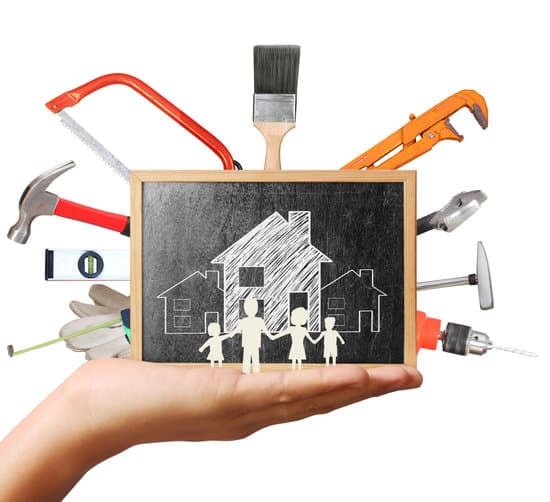Looking to make upgrades to your home but don’t have the funds upfront? In this article, we will discuss how home improvement loans work and what you need to know before applying for one.
Home improvement loans are a great resource for homeowners who want to make renovations or repairs but may not have the cash readily available. Whether it’s a personal loan, home equity loan, or another type of financing, understanding the options available is crucial in making the right decision for your home improvement project.
Home improvement loans provide homeowners with the financial means to make necessary upgrades or changes to their homes. These loans can be particularly important for homeowners who may not have substantial savings set aside for home improvement projects. By exploring different types of home improvement loans and understanding how they work, you can make informed decisions about how to finance your home improvements.
In the following sections, we will delve into the various types of home improvement loans available, qualification requirements, application process, interest rates and fees, repayment options, as well as important considerations and potential risks associated with taking out a loan for home improvements. Understanding these key aspects will help you navigate the world of home improvement financing and make the best choice for your specific situation.
Types of Home Improvement Loans
When it comes to making improvements to your home, there are several types of home improvement loans available to homeowners. One option is a personal loan, which is an unsecured loan that can be used for a variety of purposes, including home renovations.
Another option is a home equity loan, which allows homeowners to borrow against the equity in their homes. Home equity lines of credit (HELOCs) are also popular for home improvement projects, as they allow homeowners to borrow funds as needed and only pay interest on the amount borrowed.
Each type of home improvement loan has its own set of pros and cons. Personal loans typically have shorter repayment terms and higher interest rates, but they do not require collateral. Home equity loans and HELOCs often have lower interest rates and longer repayment terms, but they require using your home as collateral. It’s important to carefully consider your financial situation and goals when choosing the right type of loan for your home improvement project.
Regardless of the type of home improvement loan you choose, lenders will consider factors such as your credit score, income, debt-to-income ratio, and the amount of equity you have in your home when determining your eligibility. To improve your chances of qualifying for a loan, it’s important to work on improving your credit score, paying down existing debt, and having a clear plan for how you intend to use the funds from the loan.
Understanding how home improvement loans work can help you make informed decisions about which type of loan is best for your needs and how to go about securing one that meets those needs. By considering the pros and cons of each type of loan, understanding qualification criteria, and being aware of potential risks associated with taking out a loan, you can confidently pursue the financing needed for your next home improvement project.
How to Qualify for a Home Improvement Loan
When it comes to home improvement projects, many homeowners turn to home improvement loans to finance their renovations, remodels, or repairs. But how do home improvement loans work and what does it take to qualify for one? Here’s a closer look at the qualification process for these types of loans.
Factors that lenders consider when approving a home improvement loan:
– Credit score: Your credit score is a crucial factor that lenders consider when evaluating your eligibility for a home improvement loan. A higher credit score typically improves your chances of qualifying for a loan with favorable terms and lower interest rates.
– Income and employment: Lenders will also assess your income and employment status to determine whether you have the financial means to repay the loan. A stable source of income and steady employment history can strengthen your application.
– Equity in your home: For certain types of home improvement loans, such as home equity loans or home equity lines of credit (HELOC), the amount of equity you have in your property will be taken into consideration. The more equity you have, the more likely you are to qualify for these types of secured loans.
Tips for improving your chances of qualifying for a loan:
1. Improve your credit score: If your credit score is less than ideal, take steps to improve it before applying for a home improvement loan. This may include paying down existing debt, making timely bill payments, and correcting any errors on your credit report.
2. Reduce other debt: Lowering your overall debt-to-income ratio can make you a more attractive candidate for a loan. Consider paying off outstanding debts or consolidating them to demonstrate better financial stability.
3. Shop around for lenders: Different lenders have varying criteria and requirements for qualifying for a home improvement loan. It’s wise to compare offers from multiple lenders to find the best fit for your situation.
By understanding how home improvement loans work and what factors come into play when seeking approval, you can take proactive steps to position yourself as a strong candidate for financing your renovation or remodeling project.
Applying for a Home Improvement Loan
When it comes to making significant improvements to your home, you may find that your savings fall short of the expenses. This is where a home improvement loan can be beneficial. But how do home improvement loans work, and what is the process for applying for one?
There are several steps involved in applying for a home improvement loan. Here’s a step-by-step guide to help you through the process:
1. Research and compare lenders: Start by researching different lenders that offer home improvement loans. Look at their interest rates, fees, and terms to find the best fit for your needs.
2. Determine your loan amount: Calculate how much money you need for your home improvement project. Keep in mind that some lenders may have minimum or maximum loan amounts.
3. Check your credit score: Before applying for a loan, check your credit score to ensure it meets the lender’s requirements. A higher credit score can increase your chances of approval and could result in lower interest rates.
4. Gather necessary documentation: When applying for a home improvement loan, you will need to provide various documents such as proof of income, bank statements, and identification.
5. Fill out the application: Once you have selected a lender and gathered all necessary documents, it’s time to fill out the application for the home improvement loan.
Each lender may have specific requirements and processes in place when applying for a home improvement loan. By following these steps and being prepared with all necessary information, you can streamline the application process and increase your chances of securing the funds needed for your home improvement project.
Understanding Interest Rates and Fees
When considering home improvement loans, it is important to understand how interest rates and fees work in order to make an informed decision. Interest rates for home improvement loans can vary based on the type of loan you choose, your credit score, and the lender you work with. It’s crucial to compare interest rates from different lenders to ensure that you get the best deal possible.
Fees associated with home improvement loans can include application fees, origination fees, appraisal fees, and closing costs. These fees can add up, so it’s important to carefully review the fee structure of each loan option you are considering.
Some lenders may also charge prepayment penalties if you pay off the loan early, so be sure to inquire about this as well. Being aware of these potential fees will help you better understand the overall cost of borrowing before committing to a loan.
A useful comparison tool when researching different types of home improvement loans is the APR (Annual Percentage Rate). The APR includes both the interest rate and any additional fees that may be associated with the loan. By comparing APRs rather than just interest rates, you can get a clearer understanding of how much each loan will truly cost you over time.
| Loan Type | Interest Rate (%) | Apr (%) |
|---|---|---|
| Personal Loan | 00% | 50% |
| Home Equity Loan | 25% | 50% |
| Home Equity Line of Credit (HELOC) | 75% | 20% |
By comparing different types of home improvement loans using their corresponding APRs and total costs, you can make an informed decision on which loan option best fits your financial needs and goals.
Loan Repayment Options
When it comes to home improvement loans, understanding the repayment options is crucial for managing your finances effectively. Whether you choose a personal loan, home equity loan, or home equity line of credit for your home improvement project, the repayment terms will vary. Here’s a closer look at the different repayment options available for home improvement loans.
Fixed Monthly Payments
One common repayment option for home improvement loans is fixed monthly payments. With this option, you’ll have a set monthly payment amount that remains constant throughout the term of the loan. This can make it easier to budget and plan for your monthly expenses since you know exactly how much you need to pay each month. However, keep in mind that if you choose this option, you won’t benefit from any potential decrease in interest rates over time.
Interest-Only Payments
Some lenders may offer interest-only payments for a certain period at the beginning of the loan term. This means that initially, you’ll only be required to pay the interest on the loan amount. While this can provide temporary relief on your cash flow, it’s important to note that once the interest-only period ends, your monthly payments will increase significantly as you start paying off both the principal and interest.
Flexible Payment Options
Certain types of home improvement loans may offer flexible payment options that allow you to adjust your monthly payments based on changes in your financial situation. For example, if you experience a temporary hardship or unexpected expenses, some lenders may allow you to make lower payments or even defer payments for a short period of time. While flexibility can be beneficial, be sure to understand how it will impact the overall cost of your loan.
Understanding these repayment options will help homeowners make informed decisions when choosing a home improvement loan that suits their specific needs and financial circumstances. By carefully weighing the pros and cons of each option and considering factors such as budgeting preferences and future financial plans, homeowners can select a repayment plan that aligns with their long-term goals while minimizing potential financial strain.
Using Home Improvement Loan Funds
After securing a home improvement loan, homeowners can use the funds to enhance their properties in various ways. From minor renovations to major construction projects, the flexibility of home improvement loans allows for a wide range of applications.
Project Examples
The funds from a home improvement loan can be used for a variety of projects such as remodeling kitchens or bathrooms, adding extra space with room additions, updating the landscaping, or even making energy-efficient upgrades. Additionally, the loan can also be used for essential repairs such as fixing a leaking roof or addressing structural issues within the home.
Maximizing Loan Funds
To make the most out of your home improvement loan, it’s essential to create a detailed budget and prioritize your projects based on urgency and overall impact. By planning ahead and carefully allocating funds, homeowners can ensure that they are maximizing their loan amount and getting the most value out of their investment.
Hiring Contractors
In some cases, utilizing professional contractors is necessary for larger home improvement projects. The funds from a home improvement loan can cover the cost of labor and materials needed for these contracted services. It’s important to obtain multiple quotes from reputable contractors to ensure that you are getting the best value for your money.
Risks and Considerations
When considering taking out a home improvement loan, it’s important to weigh the risks and considerations involved. One of the main risks is taking on more debt, which can potentially strain your finances if not managed properly. Before committing to a loan, it’s crucial to carefully assess your financial situation and determine whether you can afford the additional monthly payments.
Another consideration is the potential impact on your home’s equity. Depending on the type of home improvement loan you choose, such as a home equity loan or line of credit, you are using your home as collateral. This means that if you are unable to make the payments, you could risk losing your home. It’s essential to understand the terms and conditions of the loan, as well as the potential consequences of defaulting on payments.
Additionally, it’s important to consider the overall cost of borrowing. Different types of home improvement loans come with varying interest rates and fees. It’s crucial to carefully compare and understand these costs before making a decision. Be sure to factor in any origination fees, closing costs, and ongoing maintenance fees when evaluating the total cost of borrowing.
Conclusion
In conclusion, home improvement loans provide homeowners with the financial assistance they need to make necessary updates and renovations to their homes. Whether it’s a personal loan, a home equity loan, or a home equity line of credit, there are various options available to suit different financial situations and goals. Understanding how home improvement loans work is crucial for making informed decisions about which type of loan to pursue and how to manage the repayment process.
Qualifying for a home improvement loan involves meeting certain criteria set by lenders, but there are steps that homeowners can take to improve their chances of approval. From maintaining a good credit score to providing thorough documentation of income and assets, being prepared and informed will help streamline the application process. Additionally, considering the interest rates and fees associated with different types of loans is essential for budgeting and planning the repayment strategy.
While there are benefits to taking out a home improvement loan, such as increasing property value and creating a more comfortable living space, there are also risks and considerations to keep in mind. Potential risks include overextending oneself financially and defaulting on loan payments.
Therefore, it is important for homeowners to carefully assess their financial situation before committing to any kind of loan. By weighing the pros and cons and seeking professional advice when needed, homeowners can make well-informed decisions about whether a home improvement loan is right for them.
Frequently Asked Questions
What Is the Average Length of a Home Improvement Loan?
The average length of a home improvement loan typically ranges from 5 to 20 years, depending on the lender and the specific terms of the loan. Shorter-term loans may have higher monthly payments but less interest paid over time.
What Are the Pros and Cons of Home Renovation Loans?
Home renovation loans offer the advantage of financing major projects that can increase property value, such as kitchen or bathroom remodels. However, they often come with higher interest rates and fees, and failure to repay can lead to foreclosure.
What Is the Minimum Credit Score for a Home Improvement Loan?
The minimum credit score for a home improvement loan varies depending on the lender and the type of loan. Generally, a FICO score of 620 or above is considered good enough to qualify for most home improvement loans, but some lenders may require a higher score.

I’m thrilled to have you here as a part of the Remodeling Top community. This is where my journey as an architect and remodeling enthusiast intersects with your passion for transforming houses into dream homes.





